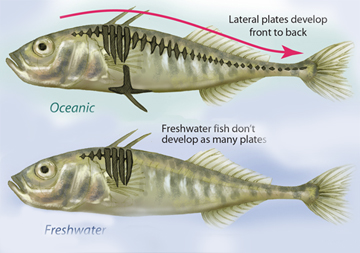Click on image for full size
Courtesy of Zina Deretsky, National Science Foundation
Fish Adapting to a Changing World
News story originally written on October 8, 2008
Scientists have been studying stickleback fish to learn more about how animals cope when their environment changes. Since the Earth is changing quickly because of global warming and other global changes, this research helps us understand how animals will adapt to a changing world. There are two main ways that the stickleback fish cope when their environment changes. First, individual fish can change the way they live their lives. Second, a whole population of animals can adapt over time through the process of microevolution by natural selection.
Some stickleback fish live in the ocean while others live in freshwater. The fish that live in the ocean have bony plates and spines for protection. These plates help the fish survive attacks by birds and other predators. Freshwater stickleback fish usually don’t have the plates, and sometimes the spines, as shown in the illustration at the left.
This change is due to the process of microevolution. For these fish, it can happen very rapidly, sometimes in only dozens of years. That’s fast for evolution. One hypothesis for why the freshwater fish no longer have the protective plates and spines is that they use their energy for growth and reproduction instead of plate production. The freshwater environment is stressful for the fish. Lakes become iced over, limiting the prey items available to stickleback throughout most of the winter, so growth and reproduction are probably better ways to survive.
Of course, it is not up to an individual fish whether it grows plates and spines. It is coded in a fish’s genes. Scientists have been studying the genes of the stickleback fish to learn which genes allow fish to develop lateral plates. They found the gene that codes for plate development. They called the gene Eda. However more gene mapping showed that in addition to Eda, two other blocks of the same chromosome were also linked to the growth of plates. Fish that had Eda and the other genes grew plates. Fish that had the recessive gene instead of Eda did not grow plates.









